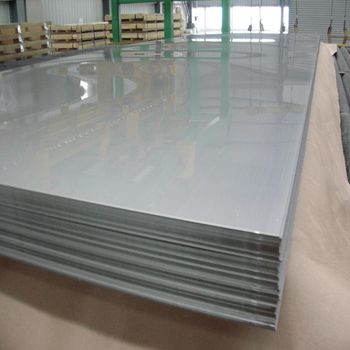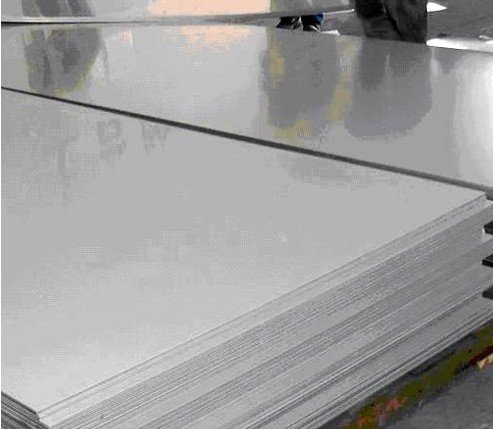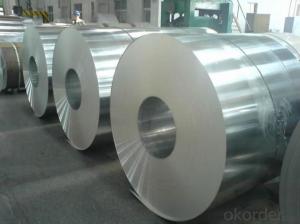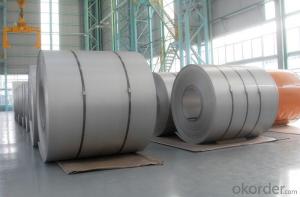430 Stainless Steel Sheet
- Loading Port:
- China Main Port
- Payment Terms:
- TT or LC
- Min Order Qty:
- 1 Ton m.t.
- Supply Capability:
- 1000 Tons Per Month m.t./month
OKorder Service Pledge
OKorder Financial Service
You Might Also Like
430 Stainless steel sheet
1. Chemical composition
|
C |
Si |
Mn |
P |
S |
Ni |
Cr |
|
max0.12 |
max1.00 |
max1.00 |
max0.04 |
max0.03 |
--- |
16.00-18.00 |
2. Mechanical properties
|
Yield Strength |
Tensile |
Elongation |
Hardness (HV) |
Hardness (HRB) |
|
≥205 |
≥420 |
≥22 |
≤200 |
≤88 |
3. Standard: AISI, ASTM, GB, EN, DIN, JIS
4. Surface: 2B, NO.1, BA, NO.4, Hairline, SB, Mirror finish, Anti-skid, Cherkered etc.
5. Size: Thickness: 0.3-3mm (cold rolled), 3-40mm (hot rolled)
Width: 1000mm or 1219mm or 1240mm for cold rolled, 1500mm for hot rolled.
Length: As customers' request.
6. MOQ: 1 Ton
7. Payment terms: T/T or L/C
8. Packing: Seaworthy package with wooden or Iron pallets with the paper and the steel strip, or as customers' request.
9. Delivery time: Usually about 7 days after we confirming the order, or according to your quantity.
If you have any question or demand, pls feel free to contact me.


- Q: What is the machinability of stainless steel strips?
- The machinability of stainless steel strips can vary depending on the specific grade and hardness of the material. Generally, stainless steel strips have good machinability compared to other types of steel due to their higher chromium content which provides improved corrosion resistance and heat resistance. However, stainless steel strips are known to be more difficult to machine compared to carbon steel due to their higher strength and work hardening tendencies. Special care and appropriate cutting tools and techniques are required to achieve the desired machining results. Additionally, the machinability of stainless steel strips may also be influenced by factors such as the presence of other alloying elements, surface finish, and the cutting conditions used.
- Q: How do stainless steel strips perform in the presence of chlorine?
- Chlorine generally does not affect the performance of stainless steel strips. Stainless steel is renowned for its ability to resist corrosion and forms a protective layer of chromium oxide on its surface. This layer acts as a barrier, preventing chlorine from corroding the steel underneath. However, under certain circumstances, stainless steel can still experience localized corrosion, such as pitting and crevice corrosion, when exposed to high levels of chlorine or other corrosive substances. Therefore, it is crucial to consider the specific grade of stainless steel used, as some grades have higher resistance to chlorine. Additionally, proper maintenance and cleaning procedures should be followed to ensure the durability and effectiveness of stainless steel strips in environments with high chlorine content.
- Q: What are the different surface finishes available for stainless steel strips?
- There are several surface finishes available for stainless steel strips, including mill finish, brushed finish, mirror finish, satin finish, and patterned finish.
- Q: Are stainless steel strips suitable for chemical pipes?
- Indeed, chemical pipes can be effectively made using stainless steel strips. Thanks to its remarkable resistance to corrosion, stainless steel proves to be an exceptional material for piping systems handling chemicals. It exhibits outstanding durability against a wide range of chemical substances, encompassing acids, alkalis, and solvents. The secret behind stainless steel's resistance to corrosion lies in the presence of chromium, which generates a protective oxide layer on the metal's surface, thus preventing further corrosion and guaranteeing the pipes' longevity. Furthermore, stainless steel is renowned for its superior strength and durability, enabling it to withstand the elevated pressures and temperatures typically associated with chemical processing. In conclusion, stainless steel strips are a dependable and fitting choice for chemical pipes.
- Q: Are stainless steel strips easy to clean and maintain?
- Stainless steel strips are renowned for their ability to resist corrosion, stains, and rust, thus making them an ideal material for a wide range of applications. When it comes to cleaning these strips, a gentle approach is key. You can employ a mild detergent or soap in combination with warm water and a soft cloth or sponge. It's important to scrub the surface in the direction of the grain to prevent any potential scratching. Once cleaned, thoroughly rinse the strips and ensure they are completely dry to avoid water spots. In terms of upkeep, maintaining stainless steel strips requires minimal effort. Regular cleaning usually suffices to keep them in pristine condition. However, should you come across stubborn stains or marks, there are stainless steel cleaners and polishes specially formulated for this purpose. These products aid in restoring the strips' luster and eliminating any residue or imperfections. Moreover, stainless steel boasts remarkable durability, eliminating the need for special treatments or coatings to preserve its quality. It is also resistant to heat, making it a suitable choice for a variety of environments, including kitchens and manufacturing facilities. All in all, thanks to their inherent qualities, stainless steel strips are relatively simple to clean and maintain. By adhering to proper cleaning techniques and utilizing appropriate products, you can ensure that your stainless steel strips remain in exceptional condition for an extended period.
- Q: Can stainless steel strips be used for structural applications?
- Stainless steel strips possess the ability to fulfill structural needs. This is due to stainless steel's exceptional resistance to corrosion, remarkable strength, and enduring nature, which render it suitable for a wide range of structural purposes. In the construction realm, stainless steel strips can be employed in the creation of buildings, bridges, and other infrastructure ventures. Moreover, they find utility in the production of machinery, automotive components, and household appliances. The adaptability of stainless steel strips allows for their manipulation into various shapes and sizes through forming, welding, and other techniques, thus making them an ideal choice for structural uses. Furthermore, the aesthetic appeal and minimal maintenance requirements of stainless steel contribute to its popularity in architectural contexts. In conclusion, stainless steel strips emerge as a trustworthy and efficient material for structural applications.
- Q: What are the different surface textures available for stainless steel strips?
- There are several different surface textures available for stainless steel strips, depending on the desired aesthetic and functional requirements. 1. No.1 Finish: This is a hot-rolled, annealed, and pickled surface finish that is characterized by a rough, dull appearance. It is commonly used for industrial applications where appearance is not a primary concern. 2. No.2B Finish: This is a cold-rolled, annealed, and pickled surface finish that is smoother and more reflective than the No.1 finish. It is commonly used for applications where a moderate level of corrosion resistance and a visually appealing finish are desired. 3. No.2D Finish: This is a cold-rolled, annealed, and pickled surface finish that is smoother and less reflective than the No.2B finish. It is commonly used for applications that require a smooth surface finish but do not require high reflectivity. 4. No.3 Finish: This is a semi-polished surface finish achieved by using a 120-150 grit abrasive. It provides a smoother and more reflective appearance than the No.2D finish but is not as highly polished as the No.4 finish. 5. No.4 Finish: This is a brushed or satin surface finish achieved by using a 150-180 grit abrasive. It provides a consistent and uniform brushed appearance and is commonly used for decorative applications where a visually appealing finish is desired. 6. No.6 Finish: This is a fine satin surface finish achieved by using a 220-240 grit abrasive. It provides a smooth and reflective appearance and is commonly used for architectural and decorative applications. 7. No.8 Finish: This is a highly polished surface finish achieved by using a 320-400 grit abrasive. It provides a mirror-like appearance and is commonly used for decorative applications where a high level of reflectivity is desired. These are some of the most common surface textures available for stainless steel strips, and each one offers unique characteristics and benefits depending on the specific application requirements.
- Q: Can stainless steel strips be used for metal stamping?
- Metal stamping can indeed make use of stainless steel strips. Due to their exceptional strength, resistance to corrosion, and long-lasting nature, stainless steel strips enjoy great popularity in metal stamping. They find extensive application in various fields, including automotive parts, appliances, and electrical components. Metal stamping techniques facilitate the easy formation, bending, and stamping of stainless steel strips into diverse shapes and sizes. Thanks to its attributes like hardness and resistance to wear, stainless steel is highly suitable for achieving precise and intricate designs through metal stamping processes. In conclusion, stainless steel strips prove to be an adaptable material that effectively serves the purpose of metal stamping.
- Q: Can 111 stainless steel strips be used in the aerospace industry?
- Yes, 111 stainless steel strips can be used in the aerospace industry.
- Q: What are the common uses of stainless steel strips in the petrochemical industry?
- Due to their exceptional qualities and characteristics, stainless steel strips are widely utilized in the petrochemical industry for various applications. In this industry, stainless steel strips find common uses in the following: 1. Heat exchangers: Crucial in petrochemical processes, heat exchangers are often manufactured using stainless steel strips. Their high corrosion resistance ensures the longevity and reliability of the heat exchangers, even in harsh operating conditions. 2. Storage tanks and vessels: Petrochemical plants require storage tanks and vessels to store chemicals and substances. Stainless steel strips are commonly used in constructing these tanks due to their excellent resistance to corrosion, chemical attacks, and high temperatures. 3. Piping systems: Preferred for fabricating piping systems, stainless steel strips provide high strength, corrosion resistance, and the ability to withstand extreme temperatures. This makes them suitable for transporting corrosive and high-pressure fluids. 4. Reactors and pressure vessels: In the petrochemical industry, reactors and pressure vessels are used for various chemical reactions and processes. Stainless steel strips are extensively utilized in constructing these critical equipment due to their durability, resistance to pitting and crevice corrosion, and ability to handle high pressures. 5. Flanges and fittings: Stainless steel strips are commonly employed in producing flanges and fittings used in petrochemical plants. These components require materials that can withstand high-pressure environments and resist corrosion, making stainless steel strips an ideal choice. 6. Instrumentation and control systems: Stainless steel strips are also used in manufacturing instrumentation and control systems in the petrochemical industry. These strips provide excellent dimensional stability, resistance to temperature fluctuations, and resistance to chemical exposure. This ensures the accuracy and reliability of the control systems. Overall, the petrochemical industry extensively relies on stainless steel strips due to their superior corrosion resistance, high strength, heat resistance, and durability. These qualities make them indispensable for critical applications where reliability and longevity are crucial factors.
1. Manufacturer Overview
| Location | Guangzhou,China |
| Year Established | 2001 |
| Annual Output Value | Above US$0.5 Million |
| Main Markets | Southeast Asia, Europe |
| Company Certifications | ISO 9001:2008; |
2. Manufacturer Certificates
| a) Certification Name | |
| Range | |
| Reference | |
| Validity Period |
3. Manufacturer Capability
| a) Trade Capacity | |
| Nearest Port | Shanghai |
| Export Percentage | 30% |
| No.of Employees in Trade Department | 10 People |
| Language Spoken: | English;Chinese |
| b) Factory Information | |
| Factory Size: | Above 30,000 square meters |
| No. of Production Lines | Above 7 |
| Contract Manufacturing | OEM Service Offered;Design Service Offered |
| Product Price Range | Average |
Send your message to us
430 Stainless Steel Sheet
- Loading Port:
- China Main Port
- Payment Terms:
- TT or LC
- Min Order Qty:
- 1 Ton m.t.
- Supply Capability:
- 1000 Tons Per Month m.t./month
OKorder Service Pledge
OKorder Financial Service
Similar products
Hot products
Hot Searches
Related keywords




























